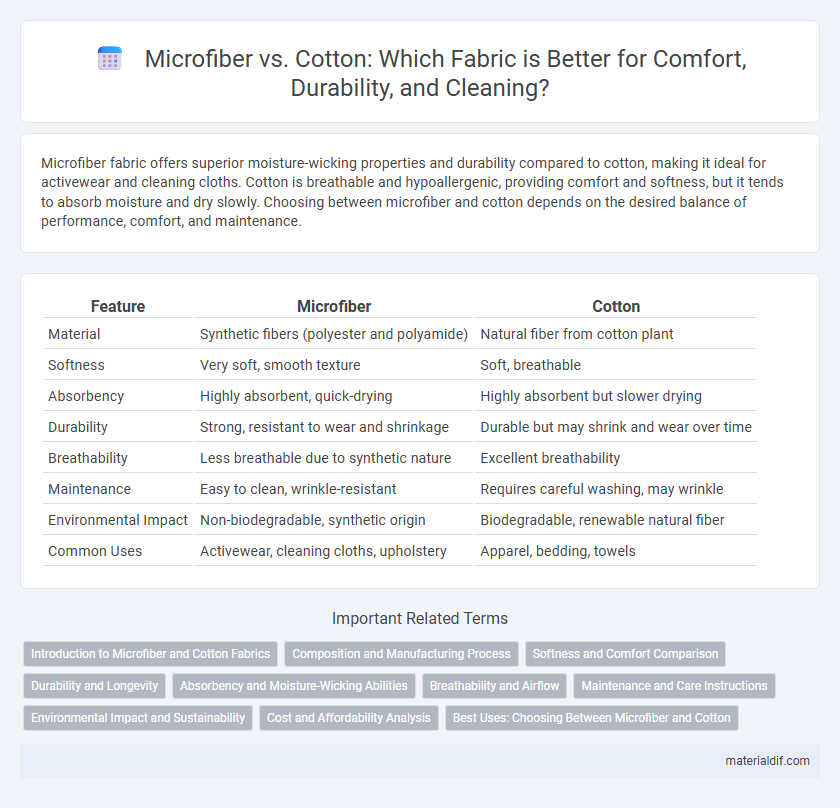Microfiber fabric offers superior moisture-wicking properties and durability compared to cotton, making it ideal for activewear and cleaning cloths. Cotton is breathable and hypoallergenic, providing comfort and softness, but it tends to absorb moisture and dry slowly. Choosing between microfiber and cotton depends on the desired balance of performance, comfort, and maintenance.
Table of Comparison
| Feature | Microfiber | Cotton |
|---|---|---|
| Material | Synthetic fibers (polyester and polyamide) | Natural fiber from cotton plant |
| Softness | Very soft, smooth texture | Soft, breathable |
| Absorbency | Highly absorbent, quick-drying | Highly absorbent but slower drying |
| Durability | Strong, resistant to wear and shrinkage | Durable but may shrink and wear over time |
| Breathability | Less breathable due to synthetic nature | Excellent breathability |
| Maintenance | Easy to clean, wrinkle-resistant | Requires careful washing, may wrinkle |
| Environmental Impact | Non-biodegradable, synthetic origin | Biodegradable, renewable natural fiber |
| Common Uses | Activewear, cleaning cloths, upholstery | Apparel, bedding, towels |
Introduction to Microfiber and Cotton Fabrics
Microfiber fabrics are made from ultra-fine synthetic fibers, typically polyester and nylon, offering high durability, moisture-wicking properties, and a soft texture ideal for activewear and cleaning cloths. Cotton, a natural fiber harvested from the cotton plant, is renowned for its breathability, comfort, and hypoallergenic qualities, making it a popular choice for everyday garments and bedding. Understanding the distinct fiber structures and performance attributes of microfiber versus cotton helps in selecting the appropriate fabric for specific uses and environmental considerations.
Composition and Manufacturing Process
Microfiber is composed of ultra-fine synthetic fibers, typically polyester and nylon, which are woven tightly to create a smooth, durable fabric. Cotton fibers originate from the natural seed hairs of the cotton plant and undergo cleaning, carding, and spinning to produce soft, breathable textiles. The manufacturing process of microfiber involves advanced extrusion techniques to split fibers into finer strands, enhancing moisture-wicking and quick-drying properties compared to the traditional, labor-intensive methods used for cotton fabric production.
Softness and Comfort Comparison
Microfiber fabric offers superior softness due to its ultra-fine synthetic fibers, which create a smooth, silky feel ideal for sensitive skin. Cotton, known for its natural breathability and moisture-wicking properties, provides comfort by allowing air circulation and temperature regulation. While microfiber excels in softness and durability, cotton delivers a more natural, breathable comfort, making the choice dependent on personal preferences for fabric feel and climate adaptability.
Durability and Longevity
Microfiber fabrics exhibit superior durability compared to cotton due to their synthetic fiber composition, which resists wear and tear more effectively. Cotton tends to degrade faster with repeated washing and exposure to sunlight, resulting in reduced longevity. High-quality microfiber can maintain its texture and strength for years, making it an ideal choice for products demanding extended lifespan.
Absorbency and Moisture-Wicking Abilities
Microfiber outperforms cotton in absorbency, with its fine synthetic fibers capable of absorbing up to seven times their weight in water, making it ideal for quick-drying applications. Cotton, a natural fiber, absorbs moisture well but retains it longer, leading to slower drying times and potential discomfort. Microfiber's superior moisture-wicking abilities transport sweat away from the skin more efficiently than cotton, enhancing breathability and keeping fabrics dryer during physical activities.
Breathability and Airflow
Microfiber fabric features tightly woven synthetic fibers that limit breathability and reduce natural airflow, often causing heat retention and moisture buildup during wear. In contrast, cotton fibers are naturally porous and allow superior air circulation, enhancing moisture wicking and keeping the skin cool and dry. The inherent breathability of cotton makes it more suitable for warm climates or active use compared to the denser, less breathable microfiber.
Maintenance and Care Instructions
Microfiber fabric requires less maintenance than cotton, as it resists stains and dries quickly, reducing the risk of mold and mildew. Cotton demands more frequent washing and careful temperature control to prevent shrinkage and color fading. To maintain microfiber's softness, machine washing in cold water and air drying are recommended, while cotton benefits from gentle cycles and avoiding high heat during drying.
Environmental Impact and Sustainability
Microfiber fabrics, made from synthetic polymers like polyester and nylon, have a lower water usage and pesticide requirement compared to cotton, which relies heavily on intensive water consumption and agrochemicals during cultivation. However, microfiber production contributes to microplastic pollution, releasing tiny plastic fibers into waterways during washing, which adversely affects marine ecosystems. Cotton is biodegradable and renewable, but its environmental footprint is significant due to high water demand and pesticide use, whereas microfiber's sustainability challenges revolve around plastic waste and non-renewability.
Cost and Affordability Analysis
Microfiber fabric generally offers a lower cost compared to cotton, making it a more affordable option for budget-conscious consumers. Cotton tends to be pricier due to its natural fibers and higher production expenses, impacting overall garment and textile pricing. Cost efficiency of microfiber is enhanced by its durability and lightweight nature, resulting in longer-lasting products that require less frequent replacement.
Best Uses: Choosing Between Microfiber and Cotton
Microfiber excels in moisture-wicking and quick-drying properties, making it ideal for activewear and performance fabrics. Cotton offers superior breathability and softness, preferred for casual wear and bedding where comfort is paramount. Selecting between microfiber and cotton depends on prioritizing durability and moisture management versus natural fibers and tactile comfort.
Microfiber vs Cotton Infographic

 materialdif.com
materialdif.com